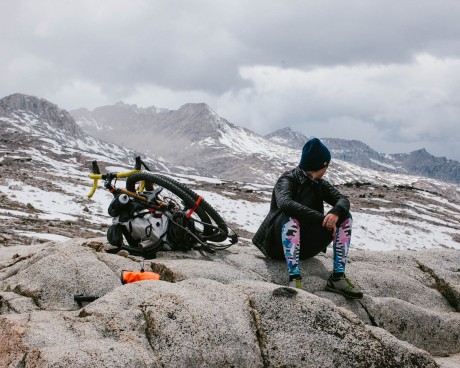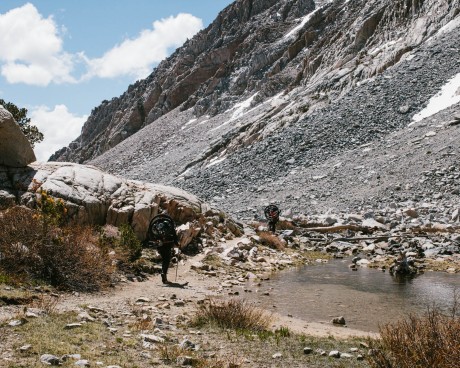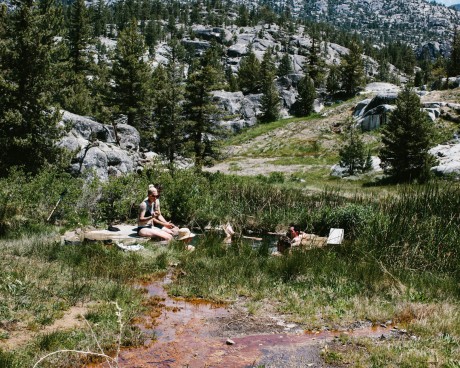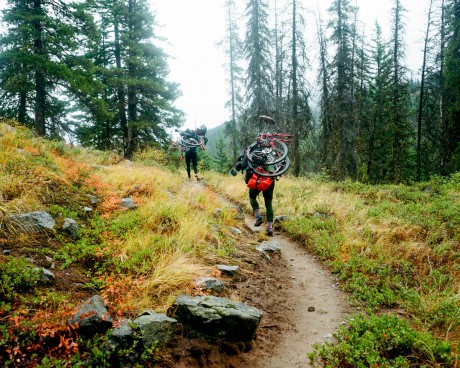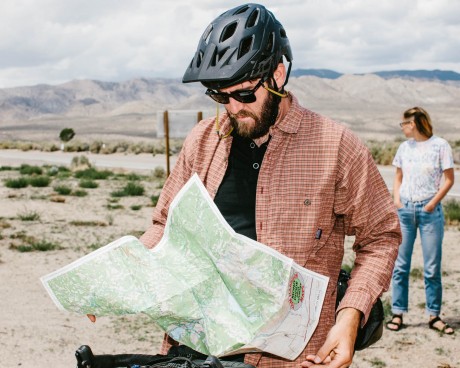
Lord Nerd Beta: Piute Pass
SECTION No1 Piute Pass: Route Prospectus
The Sierra Nevada mountain range stretches 400 miles north to south along the eastern side of California. They’re tall, jagged, formidable and incredibly picturesque, the result of a whole heap of granite formed underground during the Triassic period and then forced out of the Earth’s mantle by the tectonic process over a few million years. But the granite didn’t go softly, and it takes revenge for its acute ascension into the heavens by slashing the descending sun at the end of each day, spilling bright crimson colors across the evening sky. In spite of the region’s renowned beauty, and the common Californian’s voracious outdoor enthusiasm, much of this range remains relatively untouched and seldom visited. One reason for this unspoiled condition is the notoriously difficult access to the High Sierra. Nearly all the roads that lead in are dead ends. During the winter people aiming to go east of the Sierra must drive around them: south to Mojave or north up and over Lake Tahoe. In the summer, the trip is made only marginally shorter with the ability to go over Sonora Pass, Tioga Pass, Walker Pass or the primitive wheel-eating pavement and dirt of Sherman Pass, all of which remain closed in the winter.
But once upon a time there was a dream of another route, a path across the mountains that would link Fresno and the coast to Bishop, then on to Nevada, the midwest and beyond. That dream was called the 168.”- KVH;Much of the original 168 plan was completed. An eastern section stretches from questionably named Oasis on the border of California and Nevada, over the White Mountains via Westgard Pass, through Bishop and up to North Lake, and a western segment runs between Florence Lake and Fresno. There is, however, a noticeable and formidable gap in 168’s continuity. Never finished, the lost section of Highway 168 was a bridge too far, the terrain and climate too rugged for the original builders who were forced to abandon their project. Since that time much of the High Sierra has been designated as Wilderness, forestalling any further development on the road. What’s left is 27 miles of high mountain terrain separating the east and west sections of road.
This unfinished section through the Sierra is not completely inaccessible, but being designated as a Wilderness means mechanized travel is not allowed. There remain a few scratched out trails tramped down by hiking boots and pack animals that wind up and over hard and craggy granite passes. Lightly used, these trails are primitive and functional, and one could see how it would take only a few years of disuse for them to completely dissolve back into feral wilderness. With mechanized travel ruled out we knew that completing the 168 would require a healthy dose of hiking.
If there is one thing we have learned from our Yonder Journal experiences it is that hiking is an essential part of Bikepacking. In fact, on an average trip it would be fair to say that our time spent riding versus hiking is probably split 50/50.”- KVH;What, then, is the big difference between walking a bike—leading it if you will, like some wheeled donkey—and carrying it? Isn’t this just a matter of degrees, a seamless gradient of effort? The bottom line is that you’re moving the weight. Just because bike-on-back technology has yet to be developed—as in no one has made anything for it, as in it’s in the square wheel/raw meat eating/cave dwelling phase of refinement—doesn’t mean there is any solid reasoning against it being possible. Besides, lash-tech seems to be at the top of its game right now, given the current state of nylon. Consider the modern nylon straps, nylon buckles, and nylon fixtures that populate our world. Couldn’t we simply couple our non-bike-on-back backpacks and cutting edge lash-tech? Spice this bounty of existing technology up with a healthy dose of blind hope and heading into this there was no doubt in any of our minds that the whole thing would work out. Our plan was pretty simple, we would ride where we could, and where we couldn’t, we would pack our bikes on our backs and hike. PMA, Cut & Dry, Blind Faith.
We choose AWOLs for their versatility. Fast on the long road sections and comfortable on the climbs, these bikes shine in dirt and gravel, and our route would be a devilish mix of all the aforementioned. But the riding, though challenging, wasn’t going to be the problem. We can do that. Riding a bike is kinda our thing. It was the taking-it-apart-and-strapping-it-to-our-backs part of the deal that was going to be tough, and we knew it. No matter how advanced our lash-tech, we knew that this would be the crux. How much of a crux though, and how much we actually knew—well, suffice it to say that just like the missing segment of 168 we intended to traverse, there were some gaps in the map. When it came down to it, we all tried. In the end though only one of us would succeed, walking off alone, away from the rest of us, into a flurry of snow over an 11,000-foot pass. Our expedition to complete the 168 is a tale of failure and of triumph, an experiment in what’s possible. In the end we each limped away beaten and bruised, with a new understanding of ourselves and of possibility. A wise man waxing philosophically at the telling of this tale might say something to the effect, “That a better understanding of self is the only success you will ever need,” but sitting here writing this I’m struggling to convince myself that he’s right.
SECTION No2 Route Map
SECTION No3 Bike+Pack Setup
- 1. Fast + Stable when loaded.
- 2. Comfy for long days on variable surfaces.
- 3. Remove bottle cage bolts to prevent holes in your frame bag.
- 4. 1000% run tubeless to mitigate flats.
- 1. Load the heaviest items closer to the seatpost for the best weight distribution.
- 2. Excellent for light but bulky gear; the Mr. Fusion is stable as a rock.
- 3. Ideas: sleeping bag, clothing, camp shoes (e.g. sandals or Crocs™.)
- 1. Best for your heaviest/densest objects.
- 2. Ideas: food, stove/kitchen, tools, water.
- 1. The main compartment is good for high volume gear, while the smaller zippered pouch is perfect for all those easily accessible goods.
- 2. Ideas: sleeping bag, tent, sleeping pad, clothing; snacks, phone, camera.
- 1. You are always going to start a trip loaded heavily, so if possible lighten your backpack daily by moving weight on to the bike as food/fuel weight disappears.
- 2. Ideas: water (3 liter capacity preferable), active layers, accessories (e.g. gloves, hats), more snacks, book, sun screen, first aid, commonly used tools, rain shell, head lamp.
- 1. Integrating a fully packed bicycle onto a backpack is not an easy challenge and the methodology and equipment needed for a proper setup is still being developed. At the moment there isn't a ready made solution. With that in mind we have included a few pointers based on our experience. Remember for this route you will be splitting your time between riding and hiking.
- 2. Frame: Backpack should have structural framing, either internally or externally.
- 3. Fit: Having functional hip support is crucial, allowing you to keep the majority of the weight off your shoulders.
- 4. Capacity: Because your bike packing gear should store the majority of your supplies, capacity in the pack itself should be limited.
- 5. While not an ideal fit, Yonder Journal utilized ACRE Hausers for this trip. These bags were designed as riding packs, a purpose for which they are highly functional. While we cannot recommend the Hauser for this purpose, keep an eye on ACRE as the feedback from our trip is being used to develop a capable bag for these kinds of Bike/Hike adventures.
SECTION No4
FYI Basic/Assorted Tips
- Pack in preparation for wide temperature swings; we encountered snow, rain, and desert heat.
- Water is available while traveling in the Sierra. Water is not available while traveling over the Whites.
- Reprovisioning is available in Bishop. They have a supermarket.
- Put things in bags, keep things in bags, bags are your friends. Especially dry bags and Ziplock bags.
- Use lightweight dry bags (Sea to Summit eVAC) in place of “regular” nylon stuff sacks for electronics, clothing, sleeping bag, basically everything. A dry bag is mandatory for your sleeping bag.
- Separate food by meal by day. Pack each day separately but organize together, as a unit—smaller Ziplock bags within larger Ziplock bags.
- Pack all your camp clothes into one dry bag.
Keep bike tools in one bag. - Put like objects with like objects.
SECTION No5 Basic Packing List
SECTION No6 Piute Pass Crew

SECTION No7 Mechanical Transport

- The purpose of this ride was to travel California Highway 168 from end to end. Not just the 168 as it exists today but the whole thing. The way it was originally imagined, from Nevada to Fresno, over both the Whites and the Sierra. Most of the route is on public roads which is obviously legal and therefore a no-brainer. However, 22 miles of the route is on trail John Muir Wilderness in the Sierra and Inyo National Forests. On which trail and in which Wilderness possession/use of Mechanical Transport is 1000% illegal.
- And so, because using/possessing Mechanical Transport in a Wilderness Area is 1000% illegal, we completely disassembled our bikes: pedals off, wheels off, skewers out, chain off, seat out, etc. Then we semi-permanently attached the component parts to our backpacks where they remained (without exception, even while we slept) for the duration of our time in the Wilderness Area.
- So the question is, if you disassemble a car into thousands of pieces, including the motor, and transport the parts through the Sierra one the back of pack mules, which are legal, is that the same as driving an automobile through a Wilderness Area? We think not, we think if you disassemble a mechanism it’s no longer a mechanism.
- More importantly (semantics aside for a moment), we didn’t ride bikes in the Wilderness, nor are we advocating for others to ride bikes in the Wilderness.
- We took great pains to adhere to the law and the spirit of the Wilderness Act.

 PROJ Y Casting
PROJ Y Casting  PROJ Y WOF
PROJ Y WOF  Lunar Bikepacking
Lunar Bikepacking  Prospectus
Prospectus  The Dead Reckoning Book
The Dead Reckoning Book  starter pack
starter pack  Bikepacking 101
Bikepacking 101  Dead Reck is Dead
Dead Reck is Dead  Introduction
Introduction  Day 01
Day 01  Day 02
Day 02  Introduction
Introduction  Day 01
Day 01  Day 02
Day 02  Day 03
Day 03  Introduction
Introduction  Day 01
Day 01  Day 02
Day 02  Day 03
Day 03  Day 04
Day 04  Day 05
Day 05  Day 06
Day 06  Introduction
Introduction  Day 01
Day 01  Day 02
Day 02  Day 03
Day 03  Day 04
Day 04  Introduction
Introduction  Day 01
Day 01  Day 02
Day 02  Day 03
Day 03  Introduction
Introduction  Day 01
Day 01  Day 02
Day 02  Day 03
Day 03  Introduction
Introduction  Day 00
Day 00  Day 01
Day 01  Day 02
Day 02  Day 03
Day 03  Day 04
Day 04  Instagram Symposium
Instagram Symposium  Introduction
Introduction  Day 00
Day 00  Day 01
Day 01  Day 02
Day 02  Day 03
Day 03  Day 04
Day 04  Day 05
Day 05  Day 06
Day 06  Day 07
Day 07  Introduction
Introduction  Day 00
Day 00  Days 01-02
Days 01-02  Day 03
Day 03  Day 04
Day 04  Day 05
Day 05  Day 06
Day 06  Days 07-08
Days 07-08  Day 09
Day 09  Lord Nerd Beta
Lord Nerd Beta  Base Camp: Motel on Carroll, Dunedin
Base Camp: Motel on Carroll, Dunedin  Day 01: Dunedin to Danseys Inn
Day 01: Dunedin to Danseys Inn  Day 02: Danseys Pass to Ida Railway Hut
Day 02: Danseys Pass to Ida Railway Hut  Day 03: Ida Railway Hut to Omarama Pass
Day 03: Ida Railway Hut to Omarama Pass  Day 04: Omarama to Huxley Forks
Day 04: Omarama to Huxley Forks  Day 05: Huxely Forks to Brodrick Pass
Day 05: Huxely Forks to Brodrick Pass  Day 06: Brodrick Pass to Wanaka
Day 06: Brodrick Pass to Wanaka  Lord Nerd Beta
Lord Nerd Beta  Preface
Preface  Day 01: Charazani to Hichocollo
Day 01: Charazani to Hichocollo  Day 02: Hichocollo to Pelechuco
Day 02: Hichocollo to Pelechuco  Day 03: Pelechuco to Mountainside Bivouac #1
Day 03: Pelechuco to Mountainside Bivouac #1  Day 04: Mountainside Bivouac #1 to Hilo Hilo
Day 04: Mountainside Bivouac #1 to Hilo Hilo  Day 05: Hilo Hilo to Mountainside Bivouac #2
Day 05: Hilo Hilo to Mountainside Bivouac #2  Day 06: Mountainside Bivouac #2 to Curva
Day 06: Mountainside Bivouac #2 to Curva  Outro
Outro  Lord Nerd Beta
Lord Nerd Beta  Day 01: Oasis to Bishop
Day 01: Oasis to Bishop  Day 02: Bishop to North Lake
Day 02: Bishop to North Lake  Day 03: North Lake to Piute Pass and Back to Piute Lake
Day 03: North Lake to Piute Pass and Back to Piute Lake  Day 04: Piute Lake to Bishop
Day 04: Piute Lake to Bishop  Day 05: Mono Hot Springs
Day 05: Mono Hot Springs  Lord Nerd Beta
Lord Nerd Beta  Day 00: The Approach
Day 00: The Approach  Day 01: Tyax Lodge to Iron Pass
Day 01: Tyax Lodge to Iron Pass  Day 02: Iron Pass to Graveyard Valley
Day 02: Iron Pass to Graveyard Valley  Day 03: Graveyard Valley to Trigger Lake
Day 03: Graveyard Valley to Trigger Lake  Day 04: Trigger Lake to Tyax Lodge
Day 04: Trigger Lake to Tyax Lodge  Flooded with Feeling
Flooded with Feeling  Wilderness
Wilderness  Mike Cherney on Black Bears
Mike Cherney on Black Bears  Rope Swing
Rope Swing  Slash Piles
Slash Piles  Nylon
Nylon  Conversations with a Black Bear
Conversations with a Black Bear  US Route 93
US Route 93  Turnagain Mud Flats
Turnagain Mud Flats  Bushwhacking in British Columbia
Bushwhacking in British Columbia  Men’s Penury
Men’s Penury  Bob Dittler et. al.
Bob Dittler et. al.  Bushwhacking in the MSOJ
Bushwhacking in the MSOJ  Mike Cherney’s Knife
Mike Cherney’s Knife  Hideout, UT
Hideout, UT  Hoover Dam
Hoover Dam  Shoe Tree
Shoe Tree  Destruction
Destruction  The Siskiyou Mountain Club
The Siskiyou Mountain Club  Coral Pink Sand Dunes State Park
Coral Pink Sand Dunes State Park  EN 417 – Normes Européennes 417 – The Lindal Valve
EN 417 – Normes Européennes 417 – The Lindal Valve  Wolf Satellite
Wolf Satellite  Itchy and Scratchy
Itchy and Scratchy  Tanoak Dust
Tanoak Dust  Lake Havasu
Lake Havasu  Knife Fighting
Knife Fighting  The Comfort Inn Covenant
The Comfort Inn Covenant  The Wrong/Right Way To Experience Montauk
The Wrong/Right Way To Experience Montauk  Ohiopyle Falls
Ohiopyle Falls  Allosaurus via Lean-to
Allosaurus via Lean-to  Lyle Ruterbories, Glacier National Park Ranger
Lyle Ruterbories, Glacier National Park Ranger  Water Interface Experimentation (WIE)
Water Interface Experimentation (WIE)  OSOs & UOSOs e.g., Mt. Oberlin
OSOs & UOSOs e.g., Mt. Oberlin  Louisiana Custom Cars
Louisiana Custom Cars  Archaeologizing, Pt. II
Archaeologizing, Pt. II  Archaeologizing, Pt. I
Archaeologizing, Pt. I  Mather Point
Mather Point  Sarah Plummer Lemmon & Matt Hall
Sarah Plummer Lemmon & Matt Hall  Kangaroo Lake and Fran
Kangaroo Lake and Fran  Minor Religions of the Mt. Shasta Region
Minor Religions of the Mt. Shasta Region  The Fist Bump
The Fist Bump  The Ideal Shelter
The Ideal Shelter  Headwaters of the Sacramento River
Headwaters of the Sacramento River  Buckle Bunnies
Buckle Bunnies  DFKWA: Baldface Creek - Part I
DFKWA: Baldface Creek - Part I  Mule Deer Radio Collaring
Mule Deer Radio Collaring  The Disappearance of Everett Ruess
The Disappearance of Everett Ruess  Dall Sheep Kebabs
Dall Sheep Kebabs  The Ideal Woodsman Knife
The Ideal Woodsman Knife  DFKWA: Rough and Ready Creek - Part I
DFKWA: Rough and Ready Creek - Part I  Rowdy Water
Rowdy Water  Killing a Mountain Caribou
Killing a Mountain Caribou  Boredom, Slingshots, and Prairie Dogs
Boredom, Slingshots, and Prairie Dogs  We Would Like to Visit
We Would Like to Visit  Black Bear Ranch
Black Bear Ranch  Origins
Origins  The Heart of the Klamath
The Heart of the Klamath  Skid Town Bicycles
Skid Town Bicycles  Low Stress Management
Low Stress Management  CLUB MACHO
CLUB MACHO  Club Macho Ep. 01
Club Macho Ep. 01  Club Macho Ep. 02
Club Macho Ep. 02  Club Macho Ep. 03
Club Macho Ep. 03  Cumberland Permanent
Cumberland Permanent  Iron Goat Permanent
Iron Goat Permanent  Natchez Trace Permanent
Natchez Trace Permanent  Trail of Tears Permanent
Trail of Tears Permanent  (Dis)Enchanted Rock Permanent
(Dis)Enchanted Rock Permanent  MSOJ Permanent
MSOJ Permanent  Shorty Peak Lookout
Shorty Peak Lookout  Deer Ridge Lookout
Deer Ridge Lookout  Arid Peak Lookout
Arid Peak Lookout  Flag Point Lookout
Flag Point Lookout  Umpqua Hot Springs
Umpqua Hot Springs  Cougar Hot Springs
Cougar Hot Springs  Bagby Hot Springs
Bagby Hot Springs  Goldbug Hot Springs
Goldbug Hot Springs  Ft. Bridger Rendezvous
Ft. Bridger Rendezvous  Corndoggin’ Castle Lake
Corndoggin’ Castle Lake  Kangaroo Lake
Kangaroo Lake  The Narrows
The Narrows  Matthews Creek
Matthews Creek  Introduction
Introduction 



